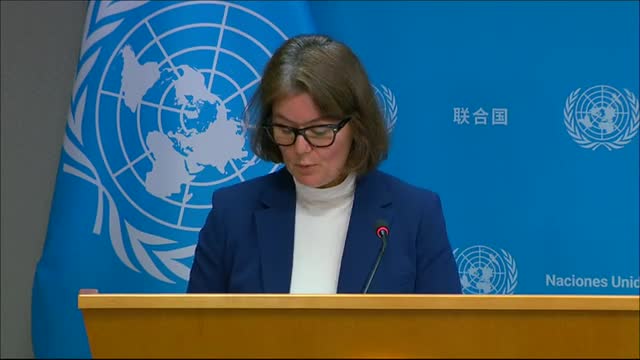UN convoy delivers aid to Gaza amid evacuation orders and ongoing airstrikes
December 23, 2024 | United Nations, Federal
This article was created by AI summarizing key points discussed. AI makes mistakes, so for full details and context, please refer to the video of the full meeting. Please report any errors so we can fix them. Report an error »

Concerns are mounting in Gaza as the Israeli authorities issued new evacuation orders for neighborhoods in West Gaza, raising fears of intensified attacks following recent aid deliveries. The areas affected, including Ash Shoujayyeh and Tarkmen, cover approximately one square kilometer, leaving civilians vulnerable and without access to essential services. Humanitarian partners are closely monitoring the situation and will provide updates on forced displacements.
In a significant development, the World Food Programme (WFP) successfully dispatched a convoy of 66 trucks on December 22, marking the first use of a newly approved route through the Philadelphia corridor to deliver food and non-food items to Central Gaza. Despite assurances of safety from Israeli authorities, an airstrike occurred nearby during the convoy's journey. While the first half of the convoy reached its destination without incident, the latter half faced delays and was exposed to looting, resulting in only 43 of the 66 trucks successfully delivering aid.
This incident underscores the urgent need for safe and unimpeded access for humanitarian assistance to reach those in dire need.
Turning to Syria, the humanitarian situation remains critical, particularly in Aleppo Governorate, where fuel shortages are severely impacting healthcare services. Six public hospitals and 60 primary health centers are operating at reduced capacity due to these shortages. Damage to infrastructure is further complicating logistics, but humanitarian partners continue to provide food assistance and support to farmers in northwest Syria.
In Northeast Syria, approximately 40,000 people are living in emergency collective centers, facing a volatile security situation that hampers aid efforts. While winter kits and clothing have been distributed, the need for additional support remains urgent, especially as access to certain areas has been restricted for weeks due to insecurity. Reports of Israeli airstrikes in Latakia and incursions in southern regions have also raised concerns about civilian infrastructure damage.
The ongoing crises in both Gaza and Syria highlight the pressing need for sustained humanitarian efforts and the protection of civilians in conflict zones.
In a significant development, the World Food Programme (WFP) successfully dispatched a convoy of 66 trucks on December 22, marking the first use of a newly approved route through the Philadelphia corridor to deliver food and non-food items to Central Gaza. Despite assurances of safety from Israeli authorities, an airstrike occurred nearby during the convoy's journey. While the first half of the convoy reached its destination without incident, the latter half faced delays and was exposed to looting, resulting in only 43 of the 66 trucks successfully delivering aid.
This incident underscores the urgent need for safe and unimpeded access for humanitarian assistance to reach those in dire need.
Turning to Syria, the humanitarian situation remains critical, particularly in Aleppo Governorate, where fuel shortages are severely impacting healthcare services. Six public hospitals and 60 primary health centers are operating at reduced capacity due to these shortages. Damage to infrastructure is further complicating logistics, but humanitarian partners continue to provide food assistance and support to farmers in northwest Syria.
In Northeast Syria, approximately 40,000 people are living in emergency collective centers, facing a volatile security situation that hampers aid efforts. While winter kits and clothing have been distributed, the need for additional support remains urgent, especially as access to certain areas has been restricted for weeks due to insecurity. Reports of Israeli airstrikes in Latakia and incursions in southern regions have also raised concerns about civilian infrastructure damage.
The ongoing crises in both Gaza and Syria highlight the pressing need for sustained humanitarian efforts and the protection of civilians in conflict zones.
View full meeting
This article is based on a recent meeting—watch the full video and explore the complete transcript for deeper insights into the discussion.
View full meeting